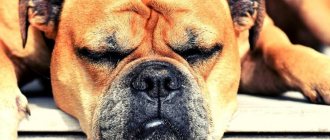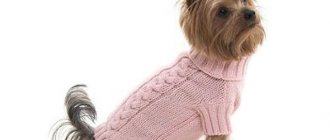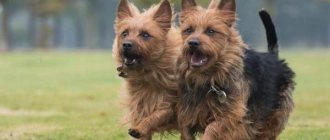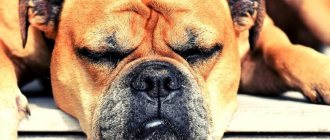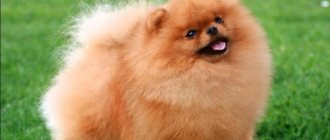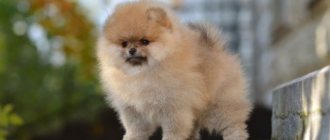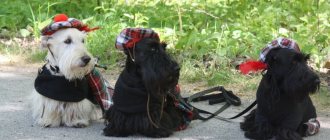In this article we will tell you why dogs grunt. We will describe the main reasons for this phenomenon, such as natural location, entry of a foreign body into the nasal passage, neoplasms, parasites, tracheal collapse, paroxysmal breathing. Let us explain what to do when a dog grunts.
All recommendations described in this article are for informational purposes only. We recommend contacting your veterinarian. Prevention of diseases and successful treatment of pets depends on timely contact with a veterinarian.
Why does a dog grunt as if it is suffocating?
An animal can wheeze for various reasons. Sometimes this happens due to the characteristics of the breed, in some cases due to illness or a foreign body entering the throat. For example, everyone knows that Yorkies pant quite often. The reasons for this may vary.
Feature of the breed
The brachycephalic group includes a sufficient number of breeds. A common characteristic feature of pets with this name is a shortened, sometimes too flattened front part of the head. Due to this anatomical structure of the muzzle, the pet has to constantly snore, sniffle, cough, sniffle, grunt or snort and even grunt.
This process does not depend on whether the dog is in a state of rest or physical stress. It is difficult for them to inhale air using a shortened nasopharynx, unlike their relatives who have elongated muzzles. Based on this, it becomes clear why the Spitz grunts. For the same reason, the Pekingese dog has a hoarse voice.
Veterinarians distinguish certain dog breeds with anatomical features. Signs may appear in:
- pugs;
- Pekingese;
- boxers;
- bulldogs;
- mastiffs;
- Shar Pei;
- Shih Tzu;
- Japanese Chins;
- Dogues de Bordeaux;
- griffins;
- Pomeranians;
- Chihuahua.
Chihuahua is one of the breeds with physiological characteristics
Entry of a foreign object
Suspicious gurgling sounds in an animal can also be caused by small debris or a large foreign object getting into the throat.
The presence of foreign objects in the nasopharynx is a common occurrence, especially given the dog's tendency to sniff everything around. Depending on the exact position of the interfering debris inside, the pet owner may hear signs of whistling, snorting, and even grunting. This condition is dangerous, as the animal cannot breathe normally, begins to sneeze and literally suffocates in front of the owner. Important! To provide first aid, you need to fix the dog's head and try to reach the cause of the symptoms with tweezers.
Helminth infection
Despite the fact that the first organ that suffers from helminths is the intestines, parasites can infect the lungs and liver. If a colony of worms affects the lungs, the dog's regular breathing will be disrupted. In this case, the pet may grunt or snore in its sleep.
Note! The presence of pulmonary parasites in puppies can be fatal. After all, the tissues of the organ are destroyed, and the dog can suffocate.
It is impossible to help a pet without consulting a specialist. Every day the form of the disease develops, bringing the dog closer to severe pneumonia and pneumonia.
Tumor
The tumor contributes to disruption of the functioning of the lungs and respiratory tract. In such a situation, the Yorkie often grunts. The dog owner should be wary if:
- while breathing, the pet gradually develops a gurgling or whistling sound;
- the animal has a cough, difficulty in inhaling or exhaling air;
- the dog’s general condition worsens, it becomes lethargic, apathetic, and sometimes refuses food;
- The dog has a runny nose with bloody mucous discharge and particles of destroyed tissue in the usual exudate.
Tracheal collapse
This is an unpleasant pathological process. Its characteristic feature is that it appears suddenly and develops unpredictably. Due to the disorder, the trachea quickly narrows, sometimes decreasing to parameters that impede the passage of air. Due to the narrowing of the lumen of the organ, the pet may experience grunting, snoring or wheezing. Sometimes the owner hears sounds that resemble quacking.
Reverse sneezing
Experts suspect that the reason for sneezing not outward, but inside the dog’s body, lies in the genetic predisposition of brachycephalic breeds. After all, about 90% of cases were recorded in this category of pets. Often the attack lasts 5-10 seconds, after which it disappears without a trace.
On a note! To find out the cause of the condition, it is recommended to conduct a full examination of the dog by a veterinarian.
Paroxysmal breathing (reverse)
In addition to grunting, sniffling and wheezing, this disorder may be accompanied by the following symptoms:
- the dog tries to spread his paws wide and arch his back inward;
- redness and bulging of the eyes appear;
- The dog actively shakes its head to the sides and scatters particles of saliva around.
Heart failure
The dog's wheezing and grunting may occur due to acute heart failure. Additional symptoms of the disease include:
- a sharp decrease in blood pressure;
- arrhythmia;
- trembling all over the body.
Yorkshire eye diseases
*We will partially answer the questions of what to do if your Yorkie’s eyes are festering or running .
Yorkies have been shown to have a predisposition to several retinal pathologies.
As a rule, these are hereditary things:
- spontaneous detachment;
- degeneration (when retinal cells die);
- dysplasia (when the retina develops abnormally).
What to do : if your Yorkshire Terrier's vision in the dark has become worse, his pupils do not constrict even in the light, or the fundus of the eye is slightly glowing gray, run to the doctor.
Dry eye is another problem for Yorkies.
The lack of fluid is provoked by a genetic disorder of the lacrimal system, in which the lacrimal canals narrow or become completely impassable.
Due to delayed outflow, the lacrimal gland often becomes inflamed. And insufficient moisture can affect the cornea or conjunctiva.
Cataracts - white and glaucoma - green clouding of the eyes of Yoriki are usually obtained from their owners; Sound scary? And they get it in the literal sense: with shampoo or a comb in the eye.
What to do : Gently groom your Yorkie's coat on his head and face. For any eye pathologies, go to a veterinary hospital.
What symptoms should you be wary of?
If a Spitz is choking and grunting, the owner should be alerted to symptoms such as:
- cough;
- weight loss;
- dyspnea;
- vomit.
In this case, the breed of the dog that grunts does not matter. For any representative of four-legged animals, such symptoms will not be a joy.
A dog's cough is a good reason to visit a veterinary clinic.
Diagnosis of respiratory organs
There are many techniques that can help establish a diagnosis. These are instrumental, laboratory, hardware, functional methods.
Diagnosis of the respiratory system includes:
- Ultrasound of the respiratory system.
- Bronchography.
- Fluorography.
- Pleurography.
- Angiography.
- Bronchoscopy.
- Laryngoscopy.
- Thoracoscopy.
- X-ray, fluoroscopy.
- Auscultation, percussion, palpation.
- Serological tests.
- Histological studies.
- CT, MRI.
- Spirometry.
When establishing a diagnosis, the history data, conditions of detention, age, and breed characteristics of the dog are taken into account. In most cases, differential diagnosis is carried out to confirm and establish an accurate diagnosis.
What to do if your dog grunts
If your dog is grunting, experienced dog breeders recommend:
- at the time of such an attack, gently stroke the pet’s throat;
- try to hold his nose; this way the dog will open its mouth and take a deep breath, which will help stop the symptoms from appearing;
- if the attack lasts a long time, perhaps a foreign object has entered the pet’s nasopharynx, the dog has had a heart attack or develops a respiratory disease, in which case the animal must be urgently taken to the veterinarian;
- if an object stuck in the throat is visible, you can try to get it out yourself;
- If your dog is short of breath due to fear in an unfamiliar or unpleasant environment, you can give him a sedative prescribed by a specialist.
Important! If symptoms recur frequently, it is recommended to undergo a course of special treatment.
Treatment
If the dog's intense breathing is not associated with external factors, you should definitely contact a veterinary clinic. Once the reason why the dog is choking is established, treatment is prescribed. However, shortness of breath is a symptom that in itself is dangerous; Hypoxia may occur with unpredictable consequences. If there is a threat of oxygen starvation, oxygen therapy may be indicated for a sick animal - inhalation of a special gas mixture with a high oxygen content. For infectious diseases and acute inflammatory processes, antibiotics and anti-inflammatory drugs are given.
Article read by 4,155 pet owners Breathing problems are more common in dogs than in cats. You can tell that your pet is choking by its open mouth, shallow, quick breaths, and sometimes by a hanging tongue.
The main method of cooling a dog's body is the method of cooling through evaporation through the evaporation of moisture from the surfaces of the mucous membranes of the upper respiratory tract. Under normal conditions, the pet takes 30-40 breaths per minute, and at high ambient temperatures, 300-400 breaths per minute.
[custom_ads_shortcode2]
Prevention measures
If, for example, a Spitz grunts and wheezes, as if it is suffocating, in order to avoid unpleasant symptoms you should:
- provide your pet with a balanced and varied diet;
- organize a room for keeping the dog so that it is warm, protected from winds and cold;
- do annual preventive deworming;
- double-check the sanitary and hygienic standards for keeping the animal.
A balanced diet is essential to maintaining your pet's health.
How can I help at home?
The dog must be provided with peace and not create additional stress on the respiratory system (avoid overheating, physical exertion, excitement). Provide fresh air flow (open a window). Under no circumstances should you try to put your dog down or give him water to drink - this can be dangerous. There is no need to use any drugs that stimulate breathing - in most cases this is not only pointless, but can also be harmful. It is necessary to take the animal to the doctor as quickly and carefully as possible.
When to contact a veterinarian
To find out why the Yorkshire Terrier grunts, or unpleasant symptoms appear in pets of other breeds, you need to contact a veterinarian if:
- bacterial or viral runny nose;
- allergic reactions;
- irritation of the mucous membrane;
- nasal congestion;
- obesity.
These diagnoses, together with all of these symptoms, can cause serious illness.
Sometimes a cute, grunting pug is not a funny dog, but an animal with health problems. The owner should monitor the condition of the pet so as not to trigger a possible disease.
Yorkshire Terrier ears
Ear diseases are always difficult for humans, let alone small Yorkies.
With their increased sensitivity, a draft is enough and inflammation of the middle ear is guaranteed.
What to do : dress your dog warmly for walks, dry it thoroughly and comb out the coat after any wetness. Don't keep your Yorkie in warm conditions - harden it: take regular and active walks in windless, not very cold weather. Be wary if your Yorkie scratches his ears or shakes his head strangely. Monitor ear odor and discharge. And don't self-medicate.
Another common problem is ear mites, which small Yorkies are more susceptible to than larger dogs.
What to do : get a vaccine for prevention, go to a clinic for treatment.
Reverse sneezing
This sign is more common in dogs of dwarf breeds with a long, narrow muzzle (toy poodle). Outwardly, it looks as if the pet has got something in its nose and is frantically trying to sneeze it out. At the same time, he draws in air and makes grunting sounds, coupled with shortness of breath and noisy breathing.
More often than not, this is not a dangerous symptom. It is necessary to do an ECHO, X-ray and exclude tracheal collapse and heart failure. The attack is short-lived, a maximum of 10 minutes; if you massage the back of the nose, it stops, the dog calms down and stops grunting.
The reasons for this phenomenon have not been studied; there is an assumption that this is due to a certain type of structure of the larynx, as well as dust and pollen entering the nasopharynx. There is no treatment.
TOP 6 causes of grunting sounds in dogs
Why does the dog grunt? This is not a typical sound for canines, so it almost always indicates a pathology, the severity of which only a doctor can understand. The list of possible and frequently diagnosed causes of a grunting sound includes:
- Foreign body in the nasal sinuses.
- Tracheal collapse (often diagnosed in Pugs, Yorkies, Spitz).
- Polyps and tumors in the respiratory tract.
- Aviary cough.
- Reverse sneezing.
- Pharyngitis.
A characteristic symptom when a dog is choking and , at the same time, grunting with its nose indicates heart failure. Often a specific symptom appears during an epileptic seizure.
Neoplasms of various origins
Tumors in the nasopharynx are diagnosed more often in dogs after 7-8 years of age and cause a specific sound reminiscent of grunting. The first signs appear suddenly in the form of shortness of breath or difficulty swallowing. The faster the tumor grows, the stronger the symptoms; it becomes difficult for the pet to eat and breathe, especially during physical exertion; he tries to “cough up” and remove the interfering tumor.
Carcinomas are found in the larynx, polyps and sarcomas are found in the nose. Favorable prognosis for polyps. If they are detected in a timely manner, surgery is performed and removed. With sarcomas and carcinomas, everything depends on the stage of the pathological process and the degree of tumor penetration into healthy tissue. In case of metastasis to other organs, surgical treatment is not justified.
Growl
Such sounds do not always indicate anger or aggression. The animal may growl out of fear. Dogs can growl to react to actions that are unpleasant or painful for them (pricks, claw trimming). With similar sounds they can react to the unknown (strangers entering the house) or protect their resources (toys, food).
The dog will also howl to warn of danger, for example, if it hears the siren of a fire truck.
Infectious tracheobronchitis
Another name is kennel cough, a respiratory disease in dogs that occurs in an acute form. Pathology provocateurs are a complex of bacterial and viral pathogens.
The disease becomes widespread in nurseries, packs of stray dogs, shelters, and anywhere where sanitary standards for keeping pets are not observed.
The main symptoms resemble pharyngitis, bronchitis, the dog coughs in fits and starts, grunts through its nose, there is discharge from the eyes and nose, and the regional lymph nodes are enlarged.
Aviary cough with a strong pet’s immunity and timely transfer to good housing, feeding occurs on its own. With the development of secondary infections and non-compliance with hygiene rules in the premises, death is possible.
Yorkie's musculoskeletal system
The fragile skeleton of this breed is susceptible to several diseases.
With congenital displacement of abnormally formed joints of the limbs, both one and both hind limbs can be affected.
This breed disorder is considered one of the most common today.
Patella luxation is a congenital condition in Yorkshire Terriers. Essentially, this is a sprain or eversion of a joint (violation of its position), sometimes accompanied by rupture of ligaments. May develop into osteoarthritis.
Despite the nature of this sore - hereditary - protect your dog from jumping and injury; Yorkies have very weak ligaments.
As sad as it is to admit, most modern Yorkies have a congenital median dislocation of the prominent lobes of the joints (the same patella).
Hereditary dislocation of the elbow , as a rule, occurs due to torn or stretched ligaments in the neighborhood. The outcome of the disease is the same as with dislocation of the calyx, only in relation to the forelimb.
Another breed problem is separation of the femoral head . With this diagnosis, the epiphysis spontaneously separates from the apophysis along the epiphyseal plate, which in turn is responsible for the development of the femur.
The main symptom: the dog is limping more and more intensely, and may not step on its paw at all. Another sign is that the Yorkie places the sore paw at an acute angle to the healthy one.
It is not uncommon for Yorkshire Terriers to suffer from separation of the head of the humerus. The same thing is observed, only for the forelimbs.
The causes of this disease are unknown. Possible causes include the dog’s misuse of vitamins and minerals.
Legg-Calvé-Perthes disease , or aseptic necrosis of the femoral head .
Yorkies under the age of one year are susceptible to it (mostly at 5-10 months), and manifests itself at 3-5 months.
Yes, Perthes has heredity, but the causes of this disease are completely unknown not only to veterinarians, but also to human doctors.
“Officially” - the blood supply to the bone tissue is disrupted, as a result of which it becomes dead and dissolves. That is, the bone of the head and neck of the femur is destroyed without an inflammatory process.
Symptoms are expected: pain when moving the hip away from the body, lameness, muscle atrophy. Surgical treatment is prescribed after x-rays of the hip joints.
Tendency to fractures . Seriously, it's innate in Yorkies.
They can break from things that other breeds are unlikely to break: a jump, a sprain, a minor fall.
Atlanto-axial instability sounds unclear and indicates pathological mobility between the 1st and 2nd cervical vertebrae of the Yorkshire Terrier.
The root of the evil is usually a congenital underdeveloped 2nd vertebra or ligamentous apparatus, rupture of ligaments due to injury or fracture of the vertebrae.
Any damage to the atlantoaxial joint puts pressure on the dog's spinal cord, causing neurological disorders: neck pain, decreased sensitivity, weakness of muscles and limbs, ataxia (discoordination).
Impaired ossification of the frontal bones (in fact, non-overgrowth of the fontanel ). Soft area at the border of bony sutures in a newborn puppy. In rare cases, there may be several fontanelles.
In weakened babies, this tissue ossifies up to 7-10 months, in healthy ones - even faster. If the fontanel has not healed before a year, there is almost a 100% chance that it will remain soft forever.
Tracheal collapse is a sharp spasm of the pharynx , resulting in difficulty breathing and suffocation.
Almost all dwarf dogs suffer from this terrible disease. It occurs due to poorly developed (soft) cartilaginous half-rings of the pharynx.
The reasons for the latter are breed, young age, regular pressure collar, metabolic disorders.
What to do : do your best to protect your Yorkie’s delicate skeleton from damage; He's had enough of congenital problems with bones and cartilage. Do not allow your dog to jump from a height (even from your hands) or get injured at all, so as not to cause serious complications. And, of course, any situation requires a private approach: from medication to surgical treatment.
Anatomy and breed specifics
Almost all owners of brachycephalic dogs claim that their pet makes “indecent” sounds, sniffles, grunts and snores. This is explained by the specific structure of the pharynx, the soft palate, which, over the course of life, relaxes and falls down, blocking the natural flow of air. Due to selection and reduction in the volume of the skull bones, soft “excess” tissues are collected in folds not only outside (Shar Pei), but also inside. This is inherent:
- French and English bulldogs.
- Pugs.
- Shar Pei.
- Japanese Chin.
Pomeranians and Yorkies are also characterized by similar grunting sounds, although they have a rather elongated and miniature muzzle. The sound increases during physical activity, after 5 years (weakening of tissues), during heat, and excitement. With the development of brachycephalic syndrome, shortness of breath, snoring and grunting sounds occur even when the pet is completely at rest.
Tracheal collapse
The etiology of the disease has not been fully studied; it is diagnosed in small breeds of dogs under the age of 2 years. Characteristic symptoms of collapse that you need to pay attention to:
- Dyspnea.
- Convulsive inhalation (“swallowing” of air).
- Cyanosis (blue discoloration) of mucous membranes and tongue.
- Nose grunting.
Due to a critical lack of oxygen, fainting and loss of coordination of movement are common. The dog becomes apathetic and stops playing. Collapse is dangerous in combination with dilated cardiomyopathy, when the parts of the heart are increased in volume.
If tracheal collapse is suspected, an X-ray examination is performed, pictures are taken during inhalation and exhalation. Tracheoscopy is considered a “talking” study, so the diagnosis can be made with 100% accuracy, but there are certain risks when administering anesthesia.
Treatment is surgical; tracheal stenting is indicated. Medicines are prescribed to relieve severe symptoms and ease breathing.
Other diseases of Yorkshire terriers
Allergies in Yorkies : symptoms and treatment.
This breed is “famous” for its tendency to allergies: hereditary and acquired.
Read as pathological sensitivity to several substances:
pollen - seasonal allergies (during flowering plants); with it, the mucous membranes of the eyes are irritated and the mucous membranes of the nose are inflamed; medications - in addition to the skin form, it can result in anaphylactic shock; products are all individual, but Yorkies are very sensitive to all sorts of vegetable and fruit delights. In addition to food allergies, the skin may be damaged; washing/detergent/cosmetic products , plus parasites (mosquitoes, fleas and others) - such an allergy is expressed by hives. That, in turn, causes “wandering” skin redness.
What to do : Doctors do not advise treating dog allergies on your own and do not welcome any cheap miracle remedies without a prescription.
Inflammation is one of the skin problems of Yorkshire Terriers. It is expressed by dermatitis (swelling), which can become wet; high temperature.
Alopecia is another skin condition in Yorkies that causes hair to suddenly fall out (mostly on the head and about the size of a coin).
Cryptorchidism is a disease in which one or both testicles do not descend into the scrotum.
Distichiasis is when your Yorkie grows extra eyelashes behind the “normal” ones.
In terms of health, the Yorkshire Terrier should be considered as a sick child versus a healthy one. Of course, this means all small dog breeds. You yourself understand that there is a difference: a Caucasian in a draft or a Yorkie in the same draft. Therefore, take care of your little ones. Be sure to dress him in the cold season, feed him properly, don’t let him jump from a height and just love him madly - sometimes this is enough.
* Why partially? Please remember that no article, no thematic forum, or even an online consultation with a veterinarian will give the same result as a normal examination of an animal in a clinic by a good doctor. If you see that your Yorkshire Terrier, Great Dane, or Nile crocodile is not feeling well, go to the doctor. To a proven, real aibolit.
Yes, I know this is the hardest thing. The most important thing for us is what we have in the lives of our beloved pets. If you've been through this, you know what I'm talking about. And therefore, having poked around veterinarians, listened to everyone, read reviews, visited clinics and lost my Scottish son Tikhon, I will tell you: firstly, not even the coolest doctor in the coolest clinic will give you any guarantees. That is, he will, of course, because you want to hear that “everything will be fine.” But no one ever knows what will really happen. How your animal’s body will react to anything or with whom your doctor will change shifts for half an hour, missing the attack of a small patient. I want to say that be prepared for anything, but believe, sincerely, with all your heart, believe in the best and wish for it.
Secondly, prepare yourself. This may sound scary, but I would like to read something like this in due time: if you do not study all the media available to you, do not communicate in veterinary queues, do not change doctors a thousand times, or - what else needs to be done to save the life of your soul mate in a dying body? - you will definitely regret it. Do your best, it's within your power. No, it's your responsibility.
Source: kotovasia.net
